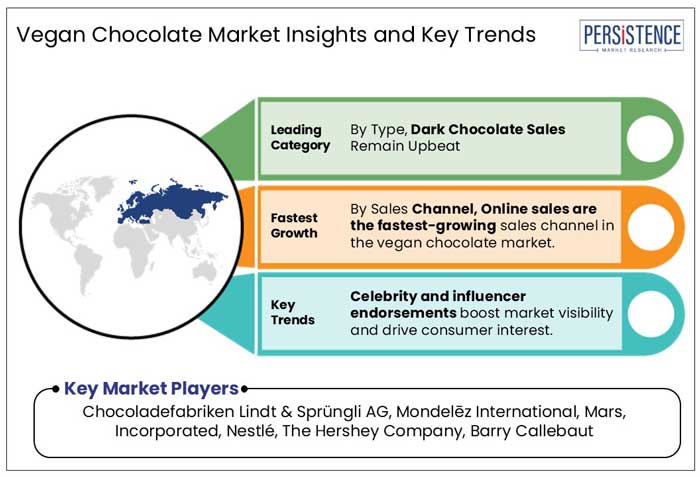Industry: Food and Beverages
Published Date: April-2025
Format: PPT*, PDF, EXCEL
Delivery Timelines: Contact Sales
Number of Pages: 146
Report ID: PMRREP33797
The global vegan chocolate market is estimated to grow from US$1,178.5 million in 2025 to US$2,707.6 million by 2032. The market is projected to record a CAGR of 12.6% during the forecast period from 2025 to 2032.
According to Persistence Market Research (PMR), the vegan chocolate industry is expected to show promising growth due to increased demand for clean-label, dairy-free, and ethically sourced chocolate. The market will witness continuous innovation in plant-based formulations, premium flavor combinations, and sustainable packaging solutions.

Key Industry Highlights
|
Global Market Attributes |
Key Insights |
|
Vegan Chocolate Market Size (2025E) |
US$ 1,178.5 Mn |
|
Market Value Forecast (2032F) |
US$ 2,707.6 Mn |
|
Projected Growth (CAGR 2025 to 2032) |
10.7% |
|
Historical Market Growth (CAGR 2019 to 2024) |
12.6% |
According to the National Institutes of Health (NIH), approximately 36% of people in the U.S. experience lactose malabsorption, making dairy-free alternatives a necessity for a large consumer base.
Health-conscious consumers are actively seeking clean-label chocolates without common allergens such as milk and gluten, and companies are responding by releasing dairy-free alternatives such as oat milk, almond milk, and coconut milk. The popularity of dark chocolate, which is naturally dairy and gluten free, has grown, particularly among people looking for functional health advantages such as antioxidants and improved heart health.
In addition, another important factor driving the growth of the vegan chocolate market is the increasing awareness of ethical and environmental issues. Consumers are becoming more conscious of the impact their dietary choices have on the environment, which has led to a higher demand for products that are sustainably sourced and cruelty-free. Vegan chocolates, which do not contain any animal-derived ingredients, align with the values of environmentally conscious consumers. As people prioritize ethical considerations in their purchasing decisions, the demand for vegan chocolate is increasing. This reflects a clear shift towards more sustainable and compassionate choices in the confectionery industry.
Vegan chocolate is much expensive than regular chocolate since it contains high-quality plant-based milk substitutes such as oat, almond, coconut, or cashew milk, which are expensive than typical dairy components. Furthermore, procuring organic, ethically farmed, and fair-trade cocoa to suit customer demand for clean-label and sustainable goods increases the overall manufacturing cost.
Unlike traditional chocolate, which has established dairy supply chains, vegan chocolate makers typically face higher ingredient procurement costs and limited supplier availability. Gluten-free, soy-free, and non-GMO ingredients further increase production costs due to the need for specialist processing and certifications. Also, due to its niche market positioning, vegan chocolate is generally made in tiny batches, resulting in high per-unit prices than mass-produced dairy chocolates.
Consumers are actively looking for chocolate enriched with superfoods that provide enjoyment and health advantages. Maca, turmeric, matcha, spirulina, and quinoa are becoming increasingly popular due to their potential to boost energy, and improve general well-being. This transition has unveiled new opportunities for companies to create nutrient-rich plant-based chocolates for health-conscious and consumers.
For example, Rad Chocolate Vegan Organic Mint & Maca Chocolate blends coconut sugar, organic mint oil, and crunchy quinoa creates a pleasant and nutritious treat. Such flavor demonstrate how functional chocolates can bring natural sweetness, unique flavors, and superfood benefits to provide a mesmerizing experience.
In today's digital world, celebrity and influencer endorsements have a significant impact on consumer preferences, and the vegan chocolate business is no different. As plant-based diets gain popularity, influencers are utilizing social platforms to encourage ethical, dairy-free alternatives further enhancing brand visibility. Celebrity-backed advertising generates curiosity while also increasing consumer trust and desirability, making vegan chocolate a popular lifestyle option.
A perfect example is Billie Eilish, an American singer-songwriter and musician who collaborated with iChoc on a Veganuary campaign in Germany.
This initiative inspired thousands of customers to switch to fair-trade, dairy-free chocolates, establishing the company's commitment to sustainability and ethical sourcing. This impact is amplified by social media platforms with influencers exhibiting new tastes, recipes, and sustainable packaging innovations, making plant-based chocolate more accessible to mainstream audiences.
Dark chocolate is a dominant category, capturing a significant share of consumer preferences. Dark chocolate is well-known for its rich cocoa taste and lower sugar content, making it a popular choice for health-conscious individuals. The increasing demand for dark chocolate is in line with the current trend of embracing plant-based options, as it typically contains very little or no dairy ingredients.
The dominant category emerges in the form of chocolate bars. Chocolate bars have entrenched themselves as a favored choice among consumers for their convenience, portability, and indulgent yet portion-controlled nature. The demand for vegan chocolate bars is propelled by the ease of consumption, making them an ideal on-the-go treat.
Furthermore, the fastest-growing category is witnessed in the realm of chocolate powder. Fueled by the surge in popularity of plant-based beverages, baking applications, and customized creations, chocolate powder has become a dynamic force. Its enables consumers to incorporate chocolatey goodness into an array of recipes, from beverages to desserts.

Europe is a dominant force in the vegan chocolate market due to cultural shifts, ethical considerations, and a strong demand for premium and sustainable food choices. European consumers, known for their discerning taste and preference for healthier lifestyles are increasingly embracing plant-based alternatives. Also, the demand is further amplified due to ethical concerns regarding animal welfare and environmental sustainability.
Europe's openness to innovation and premium offerings positions the market for sustained growth. With a robust infrastructure supporting diverse product availability, extensive retail channels, and a consumer base focused on ethical consumption, Europe emerges as a dominant region shaping the trajectory of evolving and flourishing vegan chocolate market.
Asia Pacific vegan chocolate industry is growing rapidly, fueled by ongoing innovation and boosted global investments. E-commerce has evolved into a fast-growing sales channel overtaking traditional retail stores. Consumers with a long history of plant-based diets are becoming increasingly interested in the ethical and health benefits of vegan chocolate thus driving the demand. As dietary preferences align with sustainability concerns, the population has a liking for diverse flavors and innovative chocolate formulations. The intersection of cultural heritage and a growing health-conscious consumer base positions South Asia and Pacific regions in the rapid growth of the vegan chocolate industry.
As dietary preferences align with sustainability concerns, the population has a liking for diverse flavors and innovative chocolate formulations. The intersection of cultural heritage and a growing health-conscious consumer base positions South Asia and Pacific regions in the rapid growth of the vegan chocolate industry.
Competitive intelligence is vital for dealing with the fragmented vegan chocolate market, which is packed with innovation and conscientious consumer choices. With numerous small and medium-sized companies operating alongside larger brands, no single company has a significant market share. Companies are gaining valuable insights by analyzing competitor product portfolios, pricing strategies, and distribution channels. Companies are differentiating themselves by offering unique value propositions, such as novel flavor profiles, innovative packaging, or transparent ethical sourcing.
Additionally, companies are embracing organic and fair-trade certifications to ensure ethical sourcing and sustainability, which appeals to modern customers. Key players are investing in research and development with new flavors, plant-based milk replacements, and prefer sustainable packaging options. As demand grows, collaboration among retail and e-commerce will increase accessibility, shaping the future of vegan chocolates.
|
Report Attributes |
Details |
|
Historical Data/Actuals |
2019 - 2024 |
|
Forecast Period |
2025 - 2032 |
|
Market Analysis |
Value: US$ Mn |
|
Geographical Coverage |
|
|
Segmental Coverage |
|
|
Competitive Analysis |
|
|
Report Highlights |
|
|
Customization and Pricing |
Available upon request |
By Type
By Form
By Sales Channel
By Region
To know more about delivery timeline for this report Contact Sales

The Global Vegan Chocolate Market is estimated to be valued at US$1,178.5 million in 2025.
The increasing demand for Vegan Chocolate is fueled by the rising adoption of plant-based diets and a rising preference for dairy-free, clean-label treats.
Europe leads the Global Vegan Chocolate Market, holding around 32.4% of the total share, driven by strong demand for ethical, sustainable, and plant-based confectionery options.
Dark Chocolate is the most popular and in-demand type in the Global Vegan Chocolate Market.
Chocoladefabriken Lindt & Sprüngli AG, Mondelēz International, Mars, Incorporated, Nestlé, The Hershey Company, Barry Callebaut are the leading players in the Global Vegan Chocolate market.